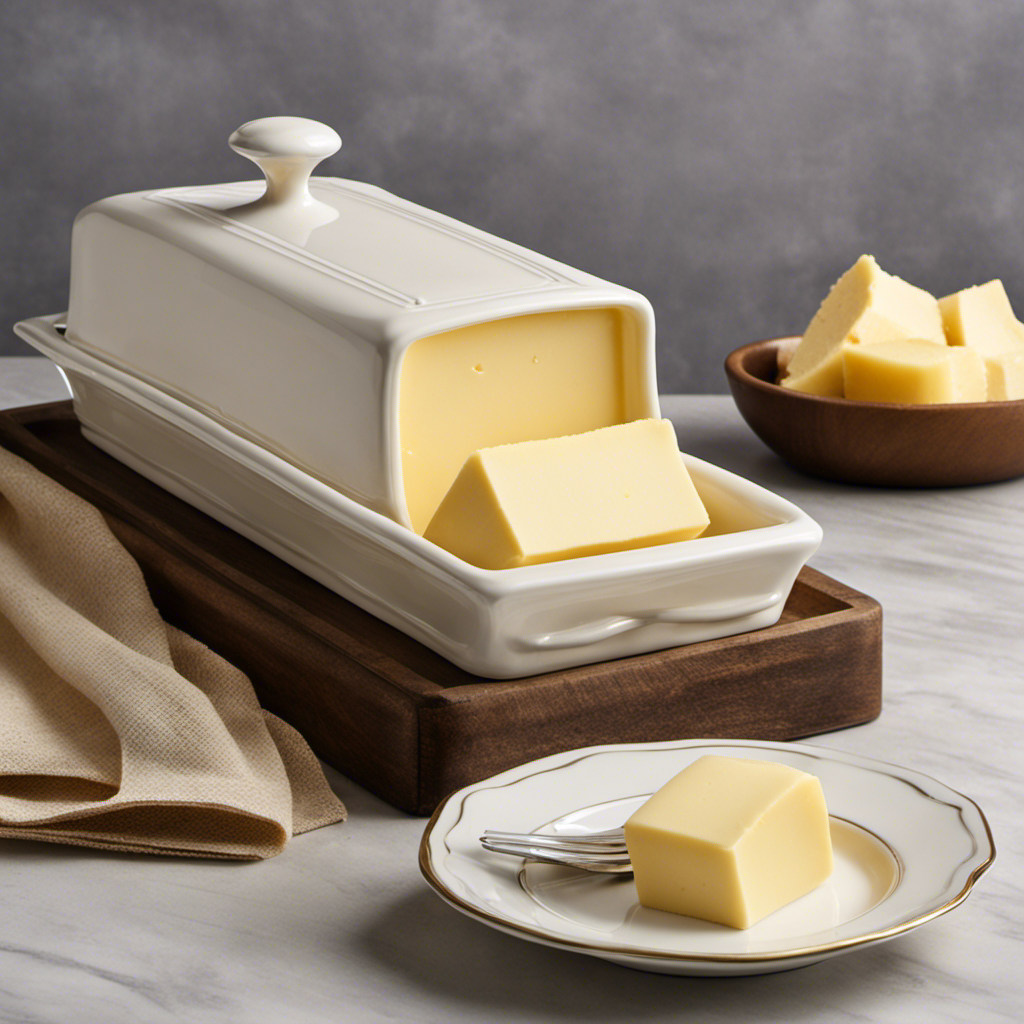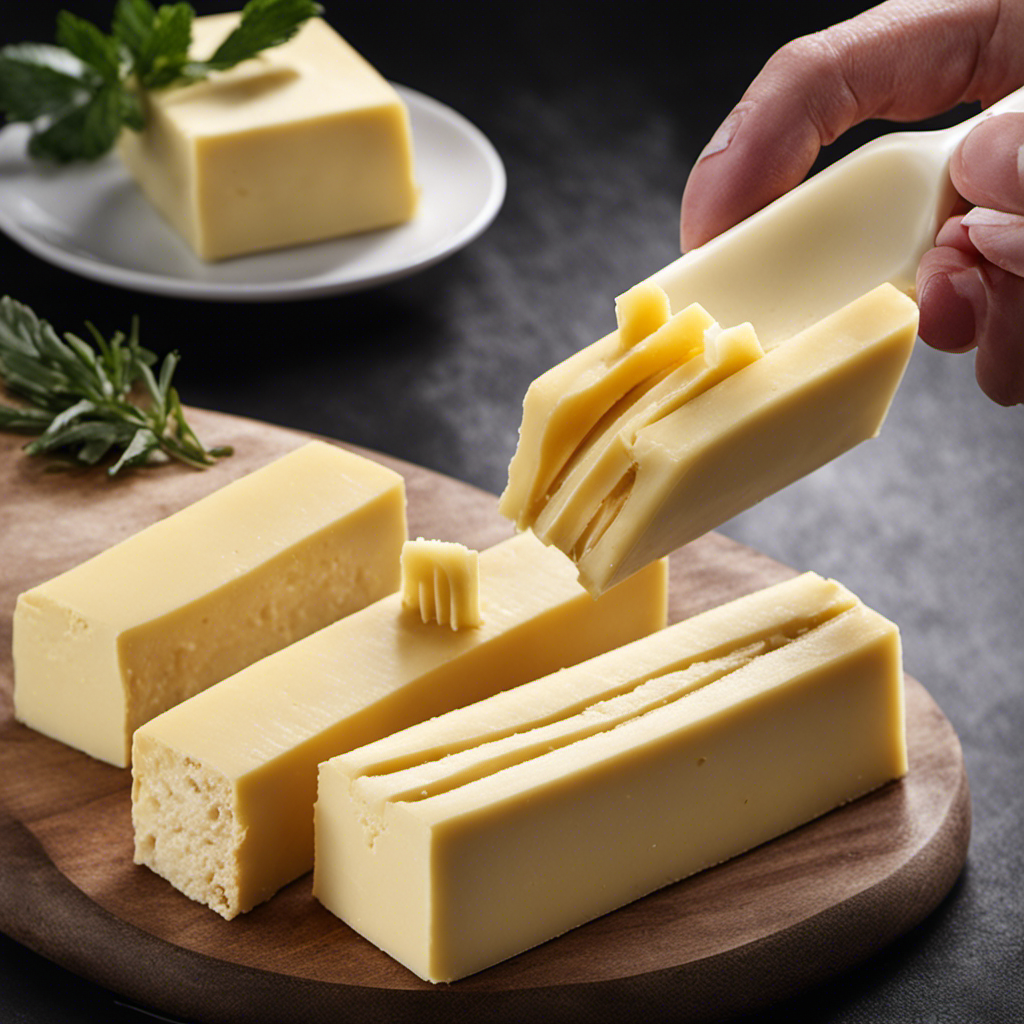Were you aware that if stored correctly, apple butter can remain good for up to a year?
In this article, I will share essential information about the shelf life of apple butter and how to ensure it stays fresh for as long as possible.
We will explore the factors that affect its longevity, proper storage techniques, and signs of spoilage to watch out for.
So, if you’re a fan of this delicious spread and want to make it last, keep reading!
Key Takeaways
- Apple butter can last up to one year when stored properly.
- Factors that affect its spoilage include the quality of ingredients used and proper cleaning and sterilization of equipment.
- Storage conditions, such as cool and dry places away from sunlight and heat, are crucial.
- Homemade apple butter can be stored in glass jars or airtight containers in the refrigerator for up to two weeks.
Shelf Life of Apple Butter
Apple butter is typically good for up to one year when stored properly. However, there are several factors that can affect its spoilage.
One of the main factors is the quality of the ingredients used. It’s important to use fresh, ripe apples and to properly clean and sterilize the equipment used for making the apple butter.
Another factor is the storage conditions. Apple butter should be stored in a cool, dry place, away from direct sunlight and heat sources. It’s also crucial to use clean, airtight containers to prevent contamination.
To ensure the longevity of homemade apple butter, it is recommended to label each jar with the date it was made and to consume the oldest jars first. Regularly inspecting the apple butter for any signs of mold or off odor is also advisable.
Factors Affecting the Shelf Life of Apple Butter
When it comes to the shelf life of apple butter, there are several factors that can affect how long it stays good.
One of the key factors is the storage conditions in which it is kept. Factors such as temperature, humidity, and exposure to light can all impact the longevity of apple butter.
Additionally, the presence of preservatives and additives can also play a role in extending the shelf life of apple butter.
Lastly, there is a difference between homemade apple butter and store-bought apple butter in terms of their shelf life, as homemade versions may not contain the same preservatives and additives as commercial brands.
Storage Conditions Impact
Proper storage conditions can greatly affect the shelf life of apple butter. To ensure that your apple butter stays fresh and delicious for as long as possible, it is important to consider the best temperature and packaging options.
Temperature plays a crucial role in preserving the quality of apple butter. The ideal temperature for storing apple butter is between 40°F and 45°F (4°C and 7°C). This temperature range helps to slow down the growth of any bacteria or mold, extending the shelf life of the apple butter.
In addition to temperature, choosing the right packaging is also important. Airtight containers, such as glass jars or plastic containers with tight-fitting lids, are ideal for storing apple butter. These containers help to prevent air and moisture from entering, which can cause spoilage.
By storing your apple butter at the best temperature and in proper packaging, you can enjoy its rich and flavorful taste for a longer period of time.
| Temperature Range | Packaging Options |
|---|---|
| 40°F – 45°F | Glass jars |
| Plastic containers with tight-fitting lids |
Preservatives and Additives
Choosing the right packaging and storing temperature for apple butter can help extend its shelf life. When it comes to commercially produced apple butter, preservatives are often added to prolong its freshness. These preservatives can include artificial additives and chemicals that may not be ideal for some individuals. However, there are natural alternatives available for those who prefer a more wholesome option.
By making apple butter at home, you have control over the ingredients and can avoid using preservatives altogether. Homemade apple butter can be stored in glass jars or airtight containers in the refrigerator for up to two weeks.
In the next section, we will explore the differences between homemade and store-bought apple butter.
Homemade Vs Store-Bought
Making your own apple butter allows you to control the ingredients and avoid the potential additives found in store-bought options. When comparing homemade apple butter to commercial ones, there are a few key differences to consider.
-
Ingredients: Homemade apple butter typically contains only a few simple ingredients like apples, sugar, and spices. On the other hand, commercial apple butter often includes additional ingredients like preservatives and artificial flavors.
-
Nutritional Value: Homemade apple butter tends to have a higher nutritional value compared to store-bought options. This is because homemade versions usually have a higher fruit content and less added sugars or unhealthy fats.
-
Taste and Texture: Many people find that homemade apple butter has a richer and more authentic taste compared to commercial ones. It also tends to have a smoother texture, since it is often made with fresh, ripe apples.
Overall, making your own apple butter allows you to enjoy a healthier and more flavorful option compared to store-bought versions.
Storing Apple Butter Properly
When it comes to the shelf life of apple butter, it’s important to store it properly to maintain its quality and safety.
The best storage conditions for apple butter include keeping it in a cool, dry place away from direct sunlight and heat sources.
Signs of spoilage to look out for include mold growth, off smells, and a change in texture or color.
Shelf Life of Apple Butter
The shelf life of apple butter depends on how it is stored and whether it has been opened or not. Factors affecting its preservation include temperature, moisture, and exposure to air. Here are some tips for a longer shelf life:
-
Store in a cool and dry place: Apple butter should be stored in a cool pantry or cupboard away from direct sunlight. Heat can cause spoilage, while moisture can lead to mold growth.
-
Keep it sealed: Once opened, apple butter should be stored in an airtight container to prevent exposure to air, which can lead to oxidation and spoilage. Use containers with tight-fitting lids or jars with vacuum-sealed lids.
-
Check for signs of spoilage: Before consuming apple butter, always check for any signs of mold, off odors, or changes in texture or color. If any of these are present, discard the apple butter to avoid foodborne illnesses.
Best Storage Conditions
Storing apple butter in a cool and dry place helps to preserve its freshness and prevent spoilage. The best storing methods for apple butter involve keeping it in an airtight container and storing it at the recommended storage temperature. Apple butter is best stored in a pantry or cupboard away from direct sunlight and heat sources. The recommended storage temperature for apple butter is between 40°F (4°C) and 50°F (10°C). This cool temperature helps to slow down the oxidation process and extend the shelf life of the apple butter. It is important to avoid storing apple butter in the refrigerator as it can cause the texture to become grainy and the flavors to change. By following these storing methods and recommended storage temperature, you can enjoy your apple butter for a longer period of time.
| Best Storing Methods | Recommended Storage Temperature |
|---|---|
| Airtight container | 40°F (4°C) to 50°F (10°C) |
| Store in a cool place | |
| Away from direct sunlight and heat sources |
Signs of Spoilage
You can tell if apple butter has spoiled by checking for mold, off smells, or a change in texture. Here are three signs to look out for:
-
Mold: If you see any fuzzy or discolored patches on the surface of your apple butter, it has likely spoiled and is not safe for consumption.
-
Off smells: Fresh apple butter has a sweet and aromatic scent. If you notice any sour, rancid, or off-putting odors, it is a clear indication that the apple butter has gone bad.
-
Change in texture: Apple butter should have a smooth and creamy consistency. If you observe any separation, clumps, or a gritty texture, it is a sign that the apple butter is no longer good to eat.
Signs of Spoiled Apple Butter
If it smells sour or has mold growing on it, your apple butter is definitely spoiled. It’s important to check for these signs of spoilage to ensure that you’re consuming safe and fresh apple butter. Mold growth on apple butter is a clear indication that it has gone bad and should not be consumed. The presence of mold can also affect the taste and texture of the apple butter, making it unpleasant to eat. Additionally, a sour or off-putting smell is another strong indicator of spoilage. It’s always better to err on the side of caution and discard any apple butter that shows these signs of deterioration. Remember to check the expiration date and store your apple butter properly to extend its shelf life and maintain its quality.
| Signs of Spoiled Apple Butter | Description | Action |
|---|---|---|
| Mold growth | Visible mold on the surface | Discard the apple butter |
| Sour smell | Unpleasant, sour odor | Do not consume, discard the butter |
Extending the Shelf Life of Apple Butter
To keep your apple butter fresh for as long as possible, make sure to seal the jar tightly after each use.
Here are three tips for extending the shelf life and preserving the freshness of your apple butter:
-
Store it in the refrigerator: Apple butter should be stored in the refrigerator to keep it fresh for a longer period. The cold temperature helps slow down the growth of bacteria and other microorganisms that can cause spoilage.
-
Use clean utensils: When scooping apple butter out of the jar, make sure to use clean utensils to prevent introducing any contaminants. This will help maintain the quality and freshness of the apple butter.
-
Avoid cross-contamination: To prevent spoilage and maintain freshness, avoid cross-contamination by not mixing apple butter with other foods or spreading it on dirty surfaces. This will help preserve the flavor and texture of the apple butter for a longer time.
Freezing Apple Butter
Preserving apple butter is essential if you want to enjoy its deliciousness long after apple season is over. One effective way to extend its shelf life is by freezing it.
Freezing apple butter is a simple and convenient method that allows you to enjoy its flavors for up to a year. To freeze apple butter, start by transferring it into airtight containers, leaving some headspace for expansion. Seal the containers tightly and label them with the date.
Place the containers in the freezer, where they will stay fresh and flavorful. When you’re ready to use it, simply thaw the frozen apple butter in the refrigerator overnight.
Freezing apple butter is a great way to preserve its taste and enjoy it for months to come.
Canning Apple Butter
Canning apple butter is a common method for preserving and enjoying its rich flavors throughout the year. It’s a simple process that allows you to store your homemade apple butter for an extended period of time.
Here are three key steps to successfully canning apple butter:
-
Prepare the apples: Start by washing and peeling the apples. Remove the cores and cut them into small pieces. You can add spices like cinnamon, nutmeg, or cloves for added flavor.
-
Cook and blend: Place the apple pieces in a large pot and cook them until they become soft and mushy. Use a blender or a food processor to puree the cooked apples until smooth. This step ensures that your apple butter has a smooth and creamy texture.
-
Sterilize and seal: Pour the apple butter into sterilized jars, leaving about 1/4 inch of headspace. Wipe the rims clean, place the lids and rings on tightly, and process the jars in a boiling water bath for the recommended time. This step will ensure that your apple butter is safely preserved for long-term storage.
By following these canning methods, you can enjoy your homemade apple butter for months to come. Experiment with different apple butter recipes to create unique flavors that suit your taste.
Happy canning!
Using Preservatives in Apple Butter
If you want your apple butter to last, using preservatives can help extend its shelf life. Preservatives are commonly used in apple products to prevent spoilage and maintain quality. They work by inhibiting the growth of bacteria, yeast, and mold, which can cause food to spoil.
While preservatives can help preserve apple butter, it is important to note that they can also affect its taste and texture. Some people may be sensitive to certain preservatives, so it is important to check the ingredients before consuming. Additionally, preservatives can alter the color and flavor of apple butter over time. Therefore, it is recommended to consume apple butter within a reasonable time frame to enjoy its optimal taste and quality.
Now, let’s move on to how to tell if apple butter has gone bad.
How to Tell If Apple Butter Has Gone Bad
When it comes to apple butter, it’s important to know how to tell if it has gone bad. Signs of spoilage can include mold, off smells, or a change in texture. However, just because it may not look or smell appealing, it doesn’t necessarily mean it’s unsafe to consume.
To ensure longevity, proper storage recommendations include keeping it in a cool, dark place and refrigerating it after opening.
Signs of Spoilage
One of the signs that apple butter has spoiled is a foul smell. When apple butter goes bad, it may develop a sour or rancid odor, indicating the growth of bacteria or mold. Factors affecting spoilage include improper storage and contamination.
To ensure the longevity of apple butter, here are some proper storage techniques:
-
Store in a cool, dark place: Exposure to heat and light can accelerate spoilage. Keep apple butter in a pantry or cupboard away from direct sunlight.
-
Seal tightly: Air is the enemy when it comes to preserving apple butter. Make sure the container is airtight to prevent the growth of bacteria.
-
Refrigerate after opening: Once opened, apple butter should be refrigerated to maintain freshness. It is recommended to consume within a few weeks.
Safe to Consume
It’s important to check for any visible signs of mold or discoloration before consuming homemade apple butter. To ensure its safety, proper storage and handling are crucial. The shelf life of homemade apple butter can vary depending on several factors, including the ingredients used and how it is stored. When stored in an airtight container and kept in the refrigerator, homemade apple butter can typically last for up to 2 months. It’s also essential to store apple butter at the recommended temperature, which is below 40°F (4°C). This helps to inhibit the growth of bacteria and maintain its freshness. Here is a table summarizing the recommended storage temperature and shelf life of homemade apple butter:
| Storage Temperature | Shelf Life |
|---|---|
| Below 40°F (4°C) | Up to 2 months |
Storage Recommendations for Longevity?
By properly storing and refrigerating homemade apple butter at temperatures below 40°F, you can extend its shelf life for up to 2 months.
To ensure the longevity of your apple butter, follow these storage recommendations:
-
Use airtight storage containers: Transfer the apple butter into clean, airtight containers to prevent exposure to air and moisture, which can lead to spoilage.
-
Properly label the containers: Label each container with the date of preparation to keep track of its freshness. This will help you identify the oldest batch of apple butter and consume it first.
-
Store in the refrigerator: Place the labeled containers in the refrigerator, preferably in the coldest part of the fridge, to maintain the low temperature required for preservation.
By following these storage guidelines, you can enjoy your homemade apple butter for an extended period.
However, if your apple butter has expired, it’s important to know how to safely consume it.
Safe Consumption of Expired Apple Butter
To safely consume expired apple butter, you should check for signs of spoilage such as mold, off smells, or changes in texture. While the expiration date is a good guideline, it is important to use your senses to determine if the apple butter is still safe to eat. Here is a table that summarizes the signs of spoilage and their implications:
| Signs of Spoilage | Implications |
|---|---|
| Moldy spots | Indicates bacterial or fungal growth. Discard the apple butter. |
| Off smells | Suggests bacterial contamination. Dispose of the apple butter. |
| Changes in texture | Could indicate bacterial growth or degradation. Avoid consuming. |
Appropriate Storage Containers for Apple Butter
When storing apple butter, it’s important to choose containers that are airtight to maintain freshness and prevent spoilage. Here are some appropriate containers and alternative storage options to consider:
-
Glass jars with tight-fitting lids: Glass jars are a popular choice for storing apple butter. They are non-reactive, meaning they won’t interact with the acidic nature of the butter, and they provide an airtight seal to keep it fresh.
-
Plastic containers with screw-on lids: Plastic containers can also be used to store apple butter. Look for containers made from food-grade plastic that have a secure screw-on lid to ensure a tight seal.
-
Freezer bags: If you prefer a more flexible storage option, freezer bags can be a good alternative. Make sure to squeeze out any excess air before sealing the bag to maintain freshness.
Frequently Asked Questions
Can I Use Expired Apple Butter?
I wouldn’t recommend using expired apple butter for baking or any other purpose. It’s important to prioritize food safety and consume products within their recommended shelf life for best results and to avoid potential health risks.
How Long Can I Store Apple Butter in the Refrigerator?
Apple butter can be stored in the refrigerator for up to 2 months. It’s important to use proper storage techniques, such as sealing it tightly. Leftover apple butter can be used in recipes or as a spread.
Can I Freeze Apple Butter in Glass Jars?
Yes, you can freeze apple butter in glass jars. It’s a convenient way to store it for longer periods. Just make sure to leave some headspace to allow for expansion.
Can I Use Plastic Containers to Store Apple Butter?
Yes, I use plastic containers to store apple butter for long term storage. To properly store apple butter and maximize its shelf life, make sure to use airtight plastic containers and store in a cool, dark place.
Can I Use Apple Butter That Has Changed Color?
I wouldn’t recommend using discolored apple butter. To prevent apple butter from changing color, store it in airtight containers, refrigerate it, and consume it within the recommended shelf life.
Conclusion
In conclusion, apple butter can be a delicious addition to your pantry, but it’s important to know how long it can be safely consumed.
By properly storing apple butter in appropriate containers and recognizing signs of spoilage, you can ensure its longevity.
Just like time can turn a ripe apple into a sweet spread, it can also cause apple butter to go bad.
So, remember to enjoy your apple butter while it’s fresh and keep an eye out for any signs of expiration.










